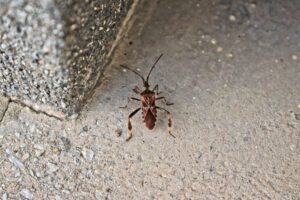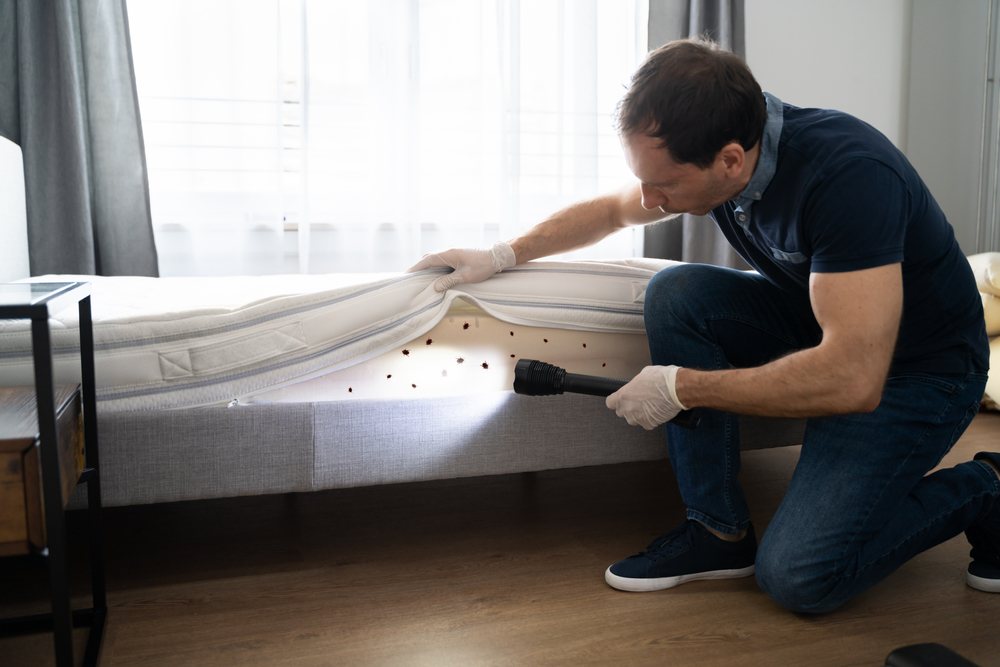It’s important to stay safe when enjoying the outdoors.
(even on your property).
Notably from insects that carry diseases that pose a risk to humans and animals.
While it’s easy to identify a mosquito flying around you, other lesser-known disease-carrying insects such as kissing bugs could be lurking.
Making sure your space is free of kissing bugs is a must when it comes to pest control and keeping your family safe at home.
Page Contents:
How to Get Rid of Kissing Bugs Outside
Kissing bugs are nocturnal flying insects with distinctive markings on their oval-shaped bodies.
They have a large snout and long antennae as well.

During the day, kissing bugs take shelter in dark, cool, dry areas where they are unlikely to be disturbed.
However, they like to remain near a food source. Since they primarily feed on blood this involves staying close to humans or animals.
Though to get rid of kissing bugs…
You will need to find them first.
Outdoor kissing bug hiding spots include:
- Wood or leaf piles.
- Inside or under equipment that is not in use.
- Or corners of the property that are not often accessed or cleaned, such as under a porch.
If there are any animals, either pets or other common visitors like raccoons or deer, be sure to check for potential hiding spots near where those animals tend to hang out.
You should also turn off any outdoor lights around your home (especially at night) to prevent kissing bugs and other potential pests from being attracted to them.
How to Get Rid of Kissing Bugs Naturally
Besides steps you can take to remove their habitats outdoors, you can also take steps to prevent kissing bugs from entering your home.
Make sure all doors and windows are adequately sealed off so that no insects are able to enter through the tiny spaces or cracks.
You will also want to check for any cracks in the walls and foundation of your home.
There are multiple natural pest control methods that can help you keep your home clear of insects like kissing bugs.
Some substances that are repellant or toxic to bugs are harmless to humans, including vinegar and certain essential oils.
These include peppermint or eucalyptus oil.
You can make a solution with water and these ingredients in a spray bottle and spray the solution on areas where kissing bugs have been found.
To make a solution with white vinegar…
Mix 1 part water, 1 part vinegar and combine.
You can add drops of eucalyptus oil to this solution to make it more potent.
A peppermint oil solution can also be made with 10 drops of oil per 30 ml of water.
(About a 3% oil-to-water ratio).
A solution such as the ones above should kill any bugs that it contacts and ward off others from your space.
It can also be sprayed repeatedly over time until insects are no longer an issue.
These solutions are also generally safe to spray on plants if you are using these in a garden, though you should check each species of plant before applying.
In addition, peppermint oil and other essential oils are known to be toxic to animals.
Avoid spraying it on areas where pets could encounter them, and research an essential oil before using it in your home.
Are Kissing Bugs Dangerous?
Like some other particularly parasitic insects, kissing bugs feed on the blood of humans and animals by biting them.
Their bites can vary in severity, from a minor reaction to something more severe with typical insect bite symptoms.
Such as:
- Redness
- Irritation
- Swelling
- and Itchiness.
Some people can experience allergic reactions from kissing bug bites that may require more attention, and an infection can occur if the bite is not properly cleaned.

However, the main danger from kissing bugs is not necessarily their bites but their potential to carry parasites and diseases.
Kissing bugs can transfer a disease or parasite that they may be carrying to human simply by biting them.
Kissing Bugs & Diseases
In particular, kissing bugs are known to carry a parasite known as Trypanosoma cruzi.
The T. cruzi parasite causes Chagas disease, also known as trypanosomiasis.
Initial infection by this parasite can cause the following symptoms:
- Nausea
- Headaches
- Fever
- Diarrhea
- and body aches.
Other symptoms include rashes and swelling at the site of the bite.
Chagas disease can be treated with anti-parasite medication. It is important to address this as soon as symptoms become noticed.
If left untreated, Chagas disease can develop into a chronic condition with gastrointestinal and cardiovascular effects that are especially dangerous to children and individuals with other compromised health conditions.
If you notice kissing bugs on your property, you should take measures to eliminate them and do whatever it takes to prevent contact between them and your family.
In addition, you should wear protective clothing while you go about ridding your home of these critters.
Insect repellent and anti-insect bed nets are also a good idea to use while these bugs are still at large.
Where are Kissing Bugs Found?
Kissing bugs prefer to live in warmer and more humid climates.
As a result, kissing bugs and Chagas disease mostly occur in Central and South America, particularly in rural areas.

However, kissing bugs are also known to live in the Southern United States.
Fewer cases of Chagas disease have occurred in the U.S. compared to other countries, but making people aware of a potentially dangerous infection is an important part of keeping case numbers low.




